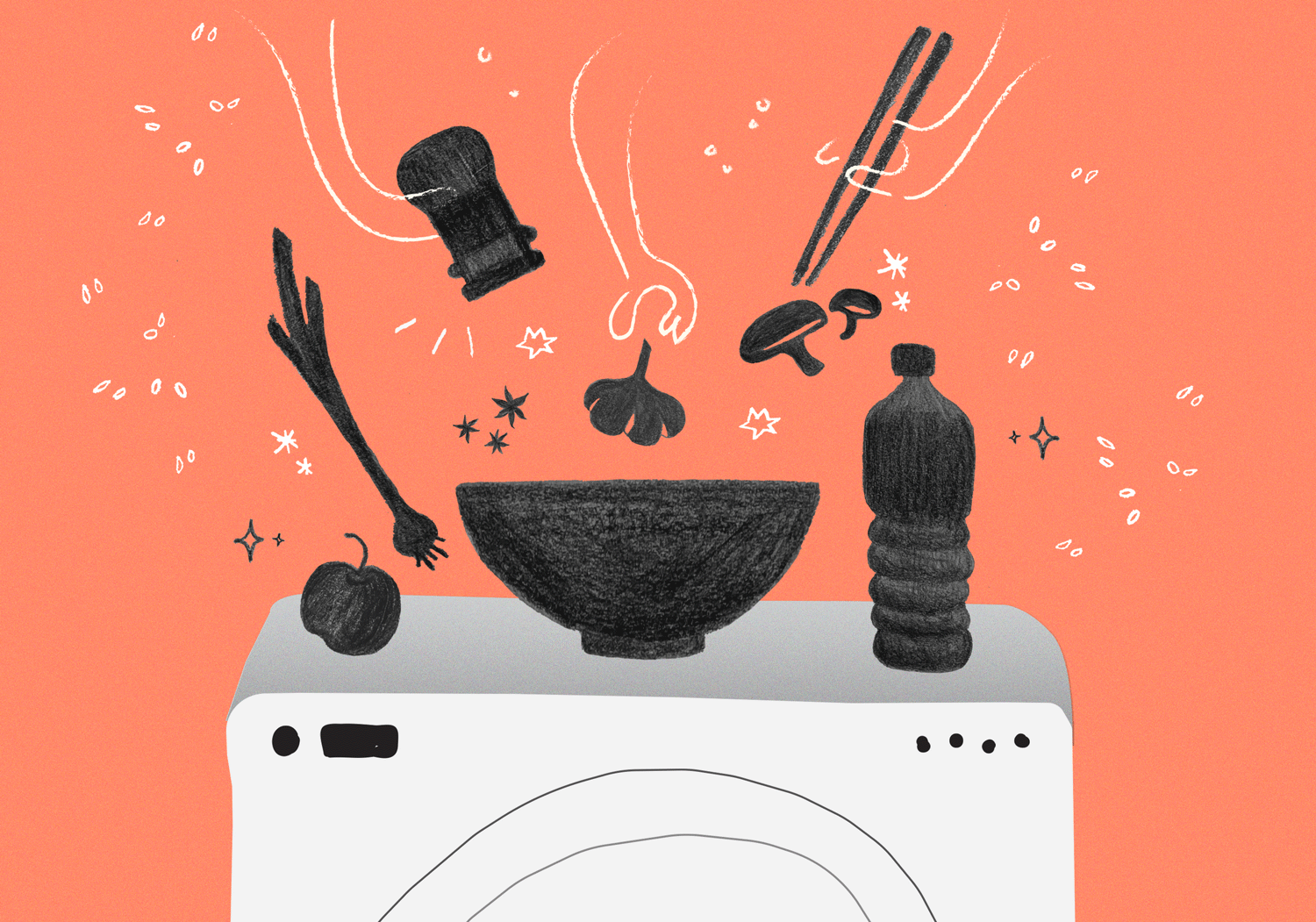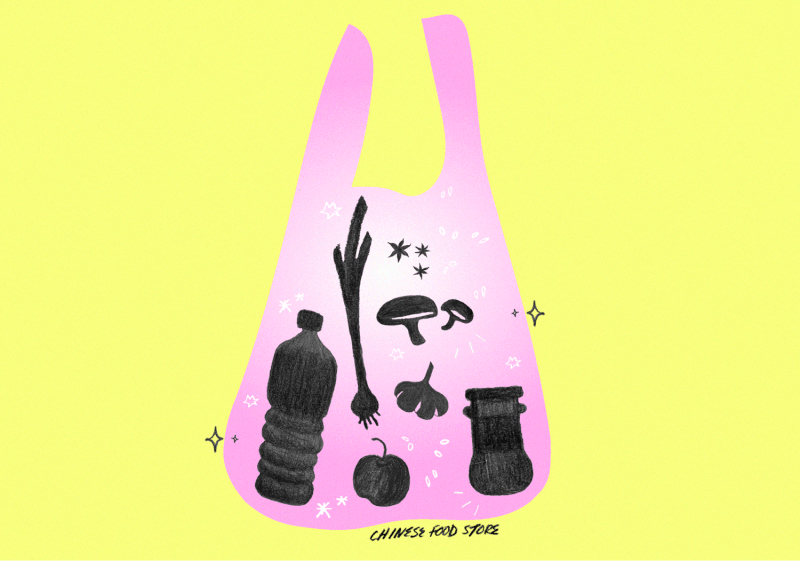
In Long Island in the ’70s and ’80s, your best bet for learning how to cook Cantonese food was in the back room of a laundromat in the suburbs.
Over a recent family dinner, I asked my grandparents for their steamed chicken with lap cheong recipe, and an argument immediately erupted in Toisan, a Cantonese dialect. I tried to keep up as my grandpa, grandma, and great-grandma all bickered over how to properly butcher a chicken. While most of it flew over my head, a side comment from my grandma caught my attention. Defending her method, she said, “That’s how we used to teach it in our classes!”
It turned out that my grandparents had taught Cantonese cooking classes inside their Long Island laundromat for years in the late ’70s and early ’80s. While the laundromat is a huge part of my family’s history that I’ve always heard retold in stories, I knew next to nothing about the cooking classes, and I was dying to know more. Why set up a cooking class inside a laundromat? What does one even cook in a laundromat? And who exactly did my grandparents wrangle to attend these classes?
My grandpa began to give me the backstory of Chinese Home Cooking, the class that he and my grandma conducted for four years. With a tiny kitchen equipped with not much else besides a hot plate, sink, and fridge, my grandparents huddled around a table, which could hold another seven students at most. Classes were intimate and casual, with my grandparents simply sharing how to make dishes they grew up with in Southern China—and even selling some ingredients at the front of the laundromat. Taking recipes from their memory, they converted eyeballed pinches of tapioca starch into precise teaspoon measurements and taste-tested everything on their kids at home. By no means were they professionals, but the appeal of homemade fried rice and soy sauce chicken was enough to draw in customers who would pay $65 per class.

Their students eagerly devoured new ingredients and adapted different cooking techniques, many of them advancing all the way to the upper-level classes. The demographics of the class also surprised me: The students were evenly split between male and female, and all were of non-Chinese descent. Unlike in Manhattan, which had its own Chinatown, Cantonese cuisine, or any type of regional Chinese cuisine for that matter, had little popularity or presence in the suburbs. But to my grandparents’ surprise, dishes like beef congee and black bean chicken were well received by these American students.
Chinese Home Cooking taught over 200 students, hailing from all different pockets of Long Island. For a pretty low-key-sounding business, I was shocked to hear that people from different counties signed up and actually attended. My grandpa explained, “In those days, The New York Times came out with a yearly list of cooking schools on Long Island, so a reporter came.”
Wait, WHAT? The New York Times wrote about the class? I asked again to make sure I’d heard correctly. He continued nonchalantly, “Oh, yeah! A reporter came to our class. She just sat in on a class, saw how it worked, then wrote about it.”
After looking up their business name on the website’s archives, I found the headline: A Full Menu of Classes in the Cuisine of Your Choice. The write-up from 1981 reads:
Esther Cho, assisted by her husband, teaches informal classes in the back of a small Chinese grocery store and laundry where students sit around a homey kitchen table. This is a good class for beginners who want to learn the basic techniques in Chinese cooking–stir frying, deep frying, steaming, poaching–as well as learning how to eat with chopsticks. Mr. Cho commented, “We’re just amateurs and don’t know everything, but we enjoy teaching what we know.” By the response of the class, the students were also having a good time. This is a demonstration class until it comes time to consuming the food prepared by Mrs. Cho–then everybody participates.
When I mentioned to my grandpa that the food must have been good if The New York Times wrote about it, he chuckled and simply said, “Well, it must have been acceptable, I guess. It’s not a big deal!”
Operating the laundromat was my grandparents’ main business, so their decision to run a cooking class in the same space didn’t make a lot of sense to me. It turns out that the business goal of the classes was to attract customers to their mini-mart, simply called Chinese Food Store, at the front of the laundromat—which was yet another side business they had under their belts. After learning how to make lo mai fan in class, you could purchase the glutinous rice, Chinese sausage, scallions, and wok needed to re-create it at home.
Before H Mart or H&Y entered suburban strip malls, Chinese Food Store was the only place on Long Island where you could find what were considered specialty ingredients back then. Bottles of sesame oil and oyster sauce sat on a makeshift plywood shelf, while the fridge was stocked with bean curds and bean sprouts, all freshly “imported” from Chinatown on a weekly basis in the trunk of my grandpa’s car.
My grandparents’ small-business endeavors sounded pretty successful to me with their full classes, local press coverage, and steady stream of customers, but they still took on more jobs to make extra money. My grandpa emphasized that the family’s financial security was his priority, as he and my grandma were first-generation immigrants. He reminds me, “Those were hard times. Grandma ran the laundry during the day. I had to work at my day job at the library, then teach the classes at night, and then on Sundays I had to drive to Chinatown to buy everything for the store, but I had to make it back in time before the library opened. And on top of all of that, I was the landlord for two houses, so I always had to take care of the tenants, too. I couldn’t spend a lot of time with your mom, aunt, and uncle when they were little because I was so busy taking care of everything else.”
While running the food store and cooking classes may have seemed like just another side job to my grandparents, their recollections tell me another story. Whether it was teaching how to cook a recipe they grew up with, providing hard-to-find groceries, or simply bringing some people together over food to make a little extra money, the laundromat brought a little bit of Cantonese culture to a small town on Long Island.
